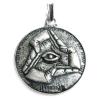Egyptian magical salvation symbol, 45 x 72 mm, 925 Antique Silver plated. The Ankh (U+2625 ☥), also known as key of life, the key of the Nile or crux ansata, was the ancient Egyptian hieroglyphic character that read "eternal life", a triliteral sign for the consonants ʻ-n-ḫ. Egyptian gods are often portrayed carrying it by its loop, or bearing one in each hand, arms crossed over their chest. The origin of the symbol remains a mystery to Egyptologists, and no single hypothesis has been widely accepted. One of the earliest suggestions is that of Thomas Inman, first published in 1869: It is by Egyptologists called the symbol of life. It is also called the 'handled cross,' or crux ansata. It represents the male triad and the female unit, under a decent form. There are few symbols more commonly met with in Egyptian art. In some remarkable sculptures, where the sun's rays are represented as terminating in hands, the offerings which these bring are many a crux ansata, emblematic of the truth that a fruitful union is a gift from the deity. Merenptah offering to Ptah: Ankh, Djed and Was. The Ankh, During the reign of Hatshepsut (1508–1458 BC), from Royal Ontario Museum E. A. Wallis Budge postulated that the symbol originated as the belt-buckle of the mother goddess Isis[citation needed], an idea joined by Wolfhart Westendorf with the notion that both the ankh and the knot of Isis were used in many ceromonies.[citation needed]. Sir Alan Gardiner speculated that it represented a sandal strap, with the loop going around the ankle[citation needed]. The word for sandal strap was also spelled ʿnḫ, although it may have been pronounced differently.
















